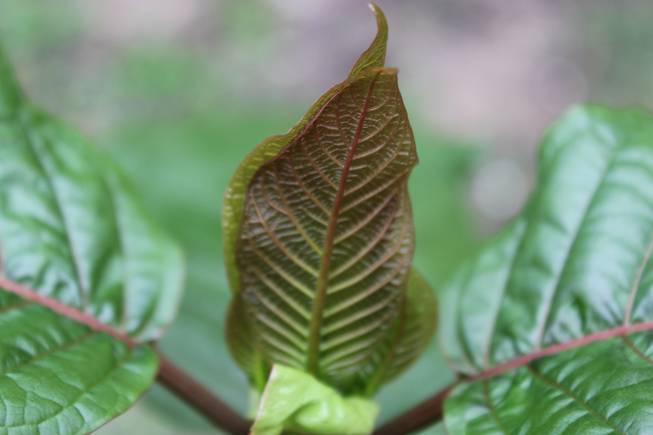
ThorPorre / Creative Commons
A leaf of Mitragyna Speciosa, also known as kratom.
Sunday, June 16, 2019 | 2 a.m.
The tropical evergreen tree kratom is native to Southeast Asia. They reach about 50 feet in height, and their leaves traditionally have been used as a stimulant and as medicine. The humidity and soil of their native environment mean kratom trees can’t withstand the desert environment of Nevada.
The leaves, though, are popular here and elsewhere in the United States for pain relief and addiction treatment. Some states have made it illegal. Nevada has not.
Here’s a look at what kratom is, what it does and what the debate around it entails, and why lawmakers in Nevada are interested in the sale of it.
Consumption
Kratom, Mitragyna speciosa, is a member of the coffee family, that sprouts leaves containing compounds that can have psychotropic (mind-altering) effects, according to the National Institute on Drug Abuse. Kratom’s leaves are traditionally chewed to produce stimulant effects. Some adherents liken it to a shot of espresso in plant form.
Chewing too much, too quickly, or taking a large enough dose in another way can make the plant’s opioid-like effects to kick in.
Chewing on an actual kratom leaf is rare in the U.S. because the plant does not grow here naturally. It’s available in capsule form, as an extract, gum or as a powder, which consumers can use to make tea or add to foods. The kratom leaf has a bitter flavor and its effects on humans begin about 30 minutes after consumption.
Where does it come from?
Southeast Asia — Thailand, Malaysia and Indonesia are the plant’s indigenous homeland. Kratom is illegal in Malaysia and Myanmar and only allowed for medicinal use in Thailand, but since the trees are native, stopping consumption is difficult there. It has been used for millennia in Southeast Asia by rural workers to increase productivity, reduce pain and, in some cases, as a poultice on wounds. In the U.S., people use it as a painkiller and as a self-administered addiction cure. “A lot of people come into kratom as an off-ramp to addiction,” said Kelly Dunn, owner of Urban Ice Organics in North Las Vegas.
Opioid properties
Opioids and opiates are different. Opiates are derived from the opium plant. Opioids are anything else that triggers the same brain receptors as opiates.
But not all opioids are created equal. Cheese contains casein proteins that stimulate those receptors, the same ones as morphine, though at an extremely reduced rate. Fentanyl is also a synthetic opioid. See the range?
Kratom is much closer to the cheese level of opioid receptor stimulation than the fentanyl level. Doses of more than 15 grams of kratom can have a more pronounced opioid affect, butDunn said the natural form of the plant was mild. Extracts, which Urban Ice does not produce or sell, can have more of an effect, he said.
Dunn has an issue with calling the effect of kratom a “high.”
It’s “similar to caffeine. Can you get high on a cup of coffee? Yeah, but you’re not going to be impaired,” he said.
Is it addictive?
Addiction centers and kratom acolytes disagree on this topic.
Research around kratom is lacking, and anecdotal reports show that many users have not encountered addictive experiences with its use.
The Mayo Clinic says kratom is not effective in treating an opioid addiction because of its own addictive effects, while other studies and organizations stop short of calling kratom addictive outright. In other words, more research is needed.
Rebecca Gasca, a lobbyist with the American Kratom Association, said the plant was not addictive.
How is it regulated?
On the federal level, kratom is not regulated.
The Food and Drug Administration warns against consuming kratom in any form until further research is done.
In August 2016, the federal Drug Enforcement Administration tried to temporarily ban kratom by using its emergency scheduling powers to define the plant as a Schedule I drug.
Thousands signed petitions to stop the scheduling and the DEA walked back its action.
Six states and Washington, D.C., have banned the plant.
Assemblymen Jim Wheeler, R-Minden, and Steve Yeager, D-Las Vegas, this year co-sponsored Assembly Bill 303 — passed by both chambers and approved by the governor— that requires vendors to make sure kratom is not mixed with another substance to the point of being “injurious to a consumer.” The bill also bans sales to consumers under the age of 18.
Wheeler said the bill was a consumer protection effort to ensure buyers get what they’re paying for.
“What we do in this building (the Nevada Legislative Building) is watch out for Nevada,” he said.
Is it dangerous?
The National Institute on Drug Abuse reports multiple deaths of people who had ingested kratom, but most involved other substances as well. The FDA came under fire in early 2018 for linking a series of deaths to kratom in which its role was uncertain.
Gasca said taking large quantities of kratom was not advised but not dangerous. “If you take it in large quantities, you’re going to get a stomachache. That’s probably going to be the biggest physical response that you experience,” she said.
Kratom mixed with other products can be dangerous because consumers don’t know what they’re consuming. It’s an issue Dunn is passionate about, and he says that buyers should have the right to know what they’re getting.
“The industry needs some guidelines. We need some regulations,” he said. “We need some enforcement too.”
Dunn said minors shouldn’t consume kratom, which he compared to other readily-available products like energy drinks.
“I feel the same way about 5-Hour Energy, Monster Energy,” he said. “I cringe at the idea that we have kids and teenagers buying those.”
This story originally appeared in the Las Vegas Weekly.
